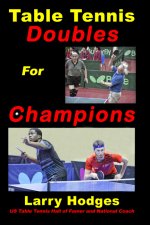I didn't read the article, but here are a few tips:
-Don't try to do nice dropshots/short pushes. Just push with spin to the middle. It will be looped, but it's not as dangerous as risk an incoming flipkill or a push into the net.
-For right handed players: if the opponents use sidespin serves, receive with a BH flick/banana flick. As you have to cover a smaller part of the table than in singles, it's much safer.
-If you're much weaker, trying to do a strong counterloop is less effective than using well placed punchblocks (thing about Harimoto style blocks from both wing). Try to be closer to the table, so you can use wider angles. The stronger player should be always further.
-Avoid using dead pushes. Higher level players usually can read it and they can loop it with more precise and faster. Also, they can loop it later, while spinny balls should be attacked earlier. Use mainly backspin and if you feel it right, sidespin pushes.
These concepts are usable when you play against higher level players in singles too, but in doubles you can go safer, if your partner is also strong. These were my experiences and the tips from a doubles match against/with 2 Hungarian second league level players and a Bundesliga 2 (or it was Reginalliga?) level player. I felt myself embarrassed... Actually we had to use 5 handicap points because of me.












